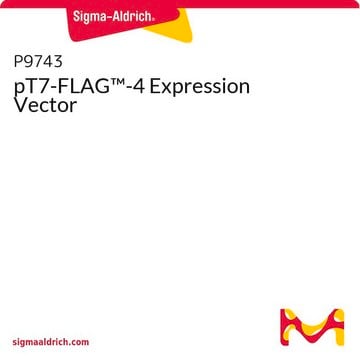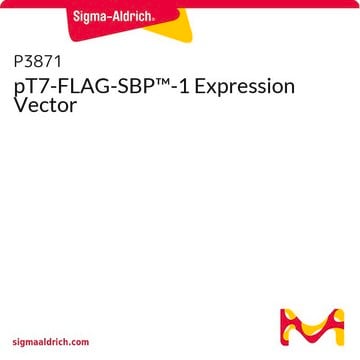Alle Fotos(1)
Wichtige Dokumente
P1118
pT7-FLAG™-1 Expression Vector
Anmeldenzur Ansicht organisationsspezifischer und vertraglich vereinbarter Preise
Alle Fotos(1)
About This Item
UNSPSC-Code:
12352200
Empfohlene Produkte
Qualität
for molecular biology
Form
buffered aqueous solution
Versandbedingung
dry ice
Lagertemp.
−20°C
Allgemeine Beschreibung
pT7-FLAG™-2 is a 4.8 kb E . coli expression vector used for cloning and cytoplasmic expression of a properly inserted open reading frame as a N-terminal Met-FLAG fusion protein containing the FLAG® epitope (DYKDDDDK). The promoter region of the very strong phage T7 promoter drives transcription of ORFFLAG fusion constructs. This vector requires the use of E. coli cells containing a source of the T7 polymerase, such as BL21(DE3)T1R cells, Catalog Number B2935.
Anwendung
pT7-FLAG®-1 Expression Vector has been used in the cloning of ubiquitin fusion protein and connexin 43 (Cx43) C-terminal fragment.
Komponenten
pT7-FLAG™-1 Expression Vector (P6742) is supplied as 0.5 mg/ml in 10 mM Tris-HCl (pH 8.0) with 1 mM EDTA.
pT7-FLAG™-1-BAP Control Vector (P6992) is supplied as 0.5 mg/ml in 10 mM Tris-HCl (pH 8.0) with 1 mM EDTA.
pT7-FLAG™-1-BAP Control Vector (P6992) is supplied as 0.5 mg/ml in 10 mM Tris-HCl (pH 8.0) with 1 mM EDTA.
Rechtliche Hinweise
FLAG is a registered trademark of Merck KGaA, Darmstadt, Germany
pT7-FLAG is a trademark of Sigma-Aldrich Co. LLC
Ähnliches Produkt
Produkt-Nr.
Beschreibung
Preisangaben
Lagerklassenschlüssel
12 - Non Combustible Liquids
Hier finden Sie alle aktuellen Versionen:
Analysenzertifikate (COA)
Lot/Batch Number
Die passende Version wird nicht angezeigt?
Wenn Sie eine bestimmte Version benötigen, können Sie anhand der Lot- oder Chargennummer nach einem spezifischen Zertifikat suchen.
Besitzen Sie dieses Produkt bereits?
In der Dokumentenbibliothek finden Sie die Dokumentation zu den Produkten, die Sie kürzlich erworben haben.
Chase T Archer et al.
The Journal of biological chemistry, 283(31), 21789-21798 (2008-06-03)
Destabilization of activator-DNA complexes by the proteasomal ATPases can inhibit transcription by limiting activator interaction with DNA. Modification of the activator by monoubiquitylation protects the activator from this destabilization activity. In this study, we probe the mechanism of this protective
Yo Sugawara et al.
The Journal of cell biology, 189(4), 691-700 (2010-05-12)
Botulinum neurotoxin is produced by Clostridium botulinum and forms large protein complexes through associations with nontoxic components. We recently found that hemagglutinin (HA), one of the nontoxic components, disrupts the intercellular epithelial barrier; however, the mechanism underlying this phenomenon is
Alasdair I Macdonald et al.
The Biochemical journal, 446(1), 9-21 (2012-06-05)
Gap junctions, composed of Cxs (connexins), allow direct intercellular communication. Gap junctions are often lost during the development of malignancy, although the processes behind this are not fully understood. Cx43 is a widely expressed Cx with a long cytoplasmic C-terminal
Ning Kong et al.
Autophagy, 16(10), 1737-1752 (2019-12-24)
Interferon-induced BST2 (bone marrow stromal cell antigen 2) inhibits viral replication by tethering enveloped virions to the cell surface to restrict viral release and by inducing the NFKB-dependent antiviral immune response. However, the mechanism by which BST2 uses the selective
Unser Team von Wissenschaftlern verfügt über Erfahrung in allen Forschungsbereichen einschließlich Life Science, Materialwissenschaften, chemischer Synthese, Chromatographie, Analytik und vielen mehr..
Setzen Sie sich mit dem technischen Dienst in Verbindung.





